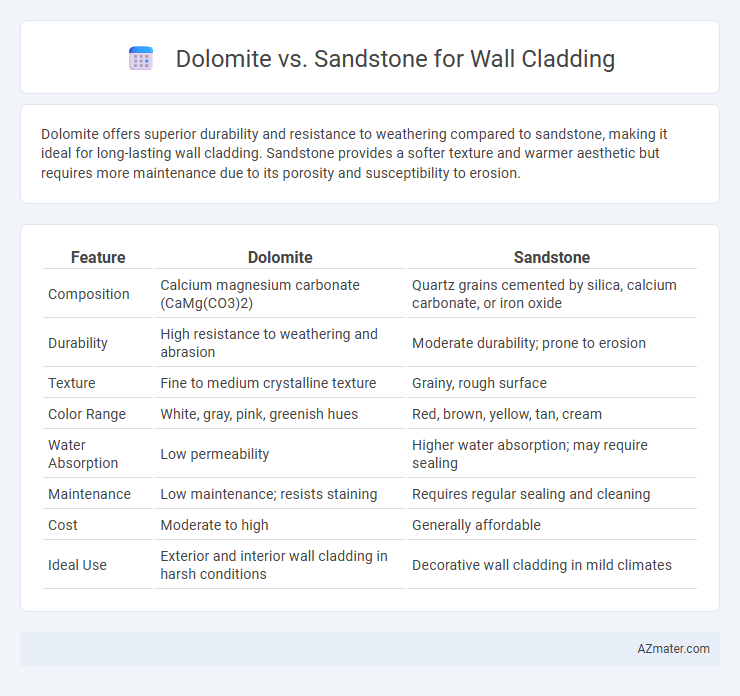Dolomite offers superior durability and resistance to weathering compared to sandstone, making it ideal for long-lasting wall cladding. Sandstone provides a softer texture and warmer aesthetic but requires more maintenance due to its porosity and susceptibility to erosion.
Table of Comparison
| Feature | Dolomite | Sandstone |
|---|---|---|
| Composition | Calcium magnesium carbonate (CaMg(CO3)2) | Quartz grains cemented by silica, calcium carbonate, or iron oxide |
| Durability | High resistance to weathering and abrasion | Moderate durability; prone to erosion |
| Texture | Fine to medium crystalline texture | Grainy, rough surface |
| Color Range | White, gray, pink, greenish hues | Red, brown, yellow, tan, cream |
| Water Absorption | Low permeability | Higher water absorption; may require sealing |
| Maintenance | Low maintenance; resists staining | Requires regular sealing and cleaning |
| Cost | Moderate to high | Generally affordable |
| Ideal Use | Exterior and interior wall cladding in harsh conditions | Decorative wall cladding in mild climates |
Introduction to Wall Cladding Materials
Dolomite and sandstone are popular natural stone choices for wall cladding due to their durability and aesthetic appeal. Dolomite offers high resistance to weathering and a smooth texture, making it suitable for both interior and exterior applications. Sandstone is valued for its rich color variations and porosity, which provides excellent thermal insulation and a distinctive rustic look.
Overview of Dolomite Stone
Dolomite stone, a sedimentary carbonate rock composed primarily of calcium magnesium carbonate, offers superior durability and resistance to weathering compared to sandstone, making it an excellent choice for wall cladding applications. Its fine-grained texture and natural color variations provide aesthetic versatility, while its high density enhances structural integrity and long-term performance. Dolomite's low porosity and resistance to acid rain contribute to its popularity in exterior architectural designs where both strength and visual appeal are essential.
Overview of Sandstone
Sandstone, a sedimentary rock composed primarily of quartz and feldspar, offers durability and natural aesthetic appeal ideal for wall cladding. Its porous structure allows for excellent insulation properties while providing resistance to weathering, making it suitable for both interior and exterior applications. The wide variety of colors and textures in sandstone enhances architectural versatility, contributing to its popularity in construction and design.
Physical Properties: Dolomite vs Sandstone
Dolomite exhibits higher hardness (3.5-4 on the Mohs scale) and greater resistance to weathering compared to sandstone, which typically ranges from 6 to 7 on the Mohs scale but varies widely due to its sedimentary nature. Dolomite's denser crystalline structure results in enhanced durability and lower porosity, making it less prone to water absorption and freeze-thaw damage than the more porous and softer sandstone. Sandstone, while offering a wider range of colors and textures, generally requires more maintenance due to its variable physical strength and susceptibility to erosion in harsh environmental conditions.
Aesthetic Appeal and Color Variations
Dolomite offers a sleek, polished appearance with natural light gray to white hues, enhancing modern architectural designs through its subtle elegance. Sandstone provides a rich palette ranging from warm reds and browns to soft yellows and tans, creating a textured and vibrant aesthetic perfect for rustic or traditional wall cladding. Both materials complement different styles, with dolomite emphasizing refined minimalism and sandstone delivering dynamic color variations that add visual warmth.
Durability and Weather Resistance Comparison
Dolomite exhibits superior durability and weather resistance compared to sandstone, making it an excellent choice for wall cladding in harsh climates. Its dense crystalline structure resists erosion, moisture absorption, and freeze-thaw cycles more effectively than the porous composition of sandstone. Sandstone, while aesthetically appealing, tends to be more susceptible to weathering and requires more maintenance to preserve its integrity over time.
Installation Process Differences
Dolomite wall cladding requires precise cutting due to its hardness, often necessitating diamond-tipped tools, resulting in longer installation times compared to sandstone. Sandstone is easier to shape and drill, allowing faster and more flexible installation, especially for intricate designs or irregular walls. Adhesion methods also differ; dolomite typically demands stronger bonding agents or mechanical anchors, while sandstone can be installed with standard mortar or adhesive, influencing labor intensity and cost.
Maintenance Requirements
Dolomite wall cladding requires minimal maintenance due to its dense and hard composition, which resists water absorption and staining. In contrast, sandstone demands more frequent sealing and cleaning to prevent weathering and salt efflorescence, as its porous nature makes it more susceptible to moisture damage. Regular inspection and prompt repair of sandstone cladding are crucial to maintain its appearance and structural integrity over time.
Cost Considerations: Dolomite vs Sandstone
Dolomite typically offers a more cost-effective solution for wall cladding compared to sandstone, as it tends to be more abundant and easier to quarry, reducing overall material expenses. Sandstone, while often pricier due to its varied coloration and aesthetic appeal, may incur higher installation costs because of its softer texture and susceptibility to weathering, which demands specialized handling. Evaluating long-term maintenance expenses is crucial, since dolomite's durability often translates to lower upkeep costs relative to the more porous and fragile nature of sandstone.
Best Applications and Recommendations
Dolomite offers superior durability and natural resistance to weathering, making it ideal for exterior wall cladding in harsh climates and high-traffic urban areas. Sandstone, with its warm appearance and easier workability, is best suited for decorative interior walls and facades in moderate weather regions. For long-lasting performance and low maintenance, choose dolomite; for aesthetic versatility and cost-effectiveness, sandstone is recommended.

Infographic: Dolomite vs Sandstone for Wall Cladding
 azmater.com
azmater.com